|
THE maintenance of an industry for two hundred years by one family, in the
direct line of succession and in one locality, is almost unique in the
history of western manufactures. Such a record proves that the successive
generations have displayed diligence, prudence, and enterprise; otherwise
it would not have been possible for them to have held continuously a
foremost place in the face of incessant competition consequent upon the
general advance in science, the introduction of superior constructional
materials, and the invention of new machinery. It indicates also the
maintenance of a high standard of workmanship as well as integrity and
business capacity; because time is the most important factor in proving
efficiency and in establishing credit for durability of work, without
which no reputation can be retained for such a long period.
The Scotts began the building of ships in Greenock
in 1711. To-day, their descendants of the sixth generation worthily
maintain the high traditions which have accumulated during the intervening
two hundred years. It is impossible to form an adequate conception of the
service rendered by this one firm to the science of marine construction
and to Britain, the leading maritime nation of the world. We should
require to review in detail the successive steps: firstly, in the
perfection of the sailing ship, from the sloops and brigantines of the
eighteenth century, to such beautiful clippers as Scotts' Lord of the
Isles, which in 1856 made the record voyage from China, and did much to
wrest from the Americans the "blue ribbon" of the ocean; and, secondly, in
the development of the steamship from its inception early in the
nineteenth century to the leviathans of to-day. In successive epochs in
the history of naval architecture the Scotts have played a creditable
part, and to some of the more important improvements initiated or advanced
by the firm reference will be made in our brief survey of the work done
during the past two centuries. Unfortunately, some years ago, most of the
old-time records were destroyed by a fire at the shipyard, so that our
review of the early work is largely from contemporary publications, and is
unavoidably incomplete.
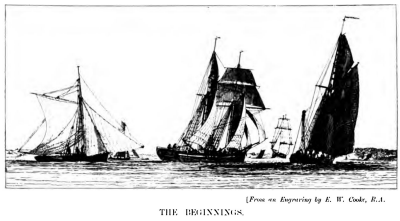
The beginnings were small, for Scotland had not yet
attained to industrial importance, and had little oversea commerce. The
first trans-Atlantic voyage made by a Clyde ship was in 1686, when a
Greenock-built vessel was employed on a special mission to carry
twenty-two persons transported to Carolina for attending conventicles and
"being disaffected to Government." American ships were most numerous on
the western seas, and the East India Company had a monopoly of the eastern
seas, so far as Britain was concerned, and preferred to build their ships
in India, although many were constructed on the south coast of England.
This monopoly checked progress. There was little or no incentive to
improvement in merchant ships, and the naval authorities were too busy
fighting Continental nations to risk extensive experimental work. We have
it on the authority of Sir Nathaniel' Barnaby, K.C.B.,' that neither
Government nor private builders made much progress in improving methods of
construction. The first letters patent granted for improvements relating
to ships bear the date January 17th, 1618, but the result of a thorough
investigation of all patents between 1618 and 1810 discloses no
improvement worth recording, except in the manufacture of sheathing and
the construction of pumps.
The Scotts, like a few other shipbuilders on the
Clyde, were concerned for the greater part of the eighteenth century in
the building of fishing and coasting boats. There belonged to Greenock, in
1728, as many as nine hundred of such fishing boats, locally built, each
carrying from twenty to twenty-four nets and manned by a crew of four men.
For many years the business of the firm consisted almost entirely in the
building of herring busses and small craft employed in the fishing trade,
the first establishment being at the mouth of the West Burn, on land
leased from the Shaw family. The shipbuilding industry was carried on
intermittently, and the Scotts were the first to give it stability and
continuity. In 1752, the Greenland whale fisheries were engaged in, and
this led to a development in the size of craft. The first square-rigged
vessel built in the port was a brig, named Greenock, constructed in 1760,
for the West Indian trade. In 1765, William Scott, who had succeeded the
original founder—his father, John Scott— built a large square-rigged ship
for some merchants of the town of Hull, the timber for which came from the
Ducal woods at Hamilton. This ship is notable as being probably the first
ship built on the Clyde for owners out of Scotland.2 To take a fairly
representative year (1776), eighteen vessels, ranging up to 77 tons, and
of a total of 1073 tons burden, were constructed in Greenock, and of the
number six were built by the Scotts.' Although the work could be more
cheaply done on the Clyde than at London or Bristol, there was for a long
time a strong prejudice against English owners ordering vessels from the
north, and against Scotch vessels taking any part in the oversea trade.
The Jacobite risings had also affected the industry,
but the War of Independence in America had far-reaching beneficial
results. It is true that prior to this the rich fields of the English
colonial possessions, as well as the English markets, had been opened to
the commerce of Scotland, and that the merchants of Glasgow had developed
extensive commercial operations with the West Indies and British North
America; but, although there was thus a considerable oversea trade between
the Clyde and the Western hemisphere, all the large vessels trading to the
Clyde were built in America. The shipbuilding industry in the States was
thus a very extensive one; and, in 1769, there were launched, in the North
American Colonies, three hundred and eighty-nine vessels of 20,000 tons
burden, which was far in excess of the annual British output. This was
largely owing to the limitless supply of timber in America, and to the
import duties on constructional material imposed in this country to suit
the English growers of oak, the price of which advanced in the eighteenth
century from £2 15s. to £7 7s. per load.
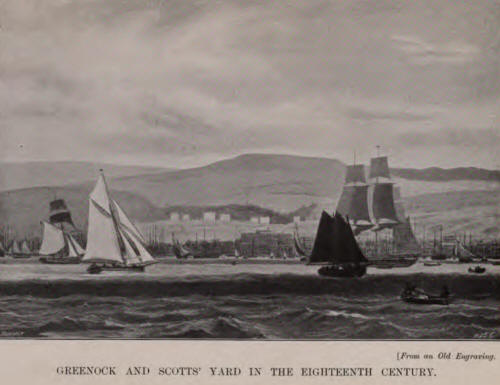
The Brunswick, of 600 tons, carpenters' measurement,
to carry 1000 tons real burden, built by the Scotts in 1791 for the Nova
Scotia trade; and the Caledonia, of 650 tons, built by the Scotts in 1794,
for the carriage of timber for the Navy yards—each the largest ship in
Scotland of its respective year- signalised the beginning of a period of
greater activity, especially in respect of large ocean ships. Some years
before-1767—the Scotts had feued ground for a building yard on the shore
east of the West Burn. They added a graving dock of considerable size, and
the inaugural proceedings included a dinner held on the floor of the dock.
Other developments contributed to the prosperity of
the port of Greenock, the chief of the establishment being John Scott of
the third generation, who was born in 1752, and died in 1837. His brother,
William Scott, also the second of that name, migrated to Bristol, where he
carried on an extensive trade as a shipbuilder. The latter was the father
of James M. Scott, who is still remembered by some old inhabitants as the
founder, about 1847, of penny banks in Greenock and of the Artisans' Club.
John Scott, after his brother's departure, carried on the business under
the name of John Scott and Sons, and did great service not only for the
town, but also for the advancement of the business. In three successive
years, 1787, 1788, and 1789, he bought three large plots from the ninth
Lord Cathcart, for the extension of the works.' These then extended almost
from the West Quay to the West Burn. He also, in 1791, constructed the old
steamboat or custom-house quay,2 and played a large part in developing the
banking facilities of the town. He bought, in 1815, Halkshill, near Largs,
which has continued the residence of the family. In view of the
association of the firm with the town, it may be worth interpolating here
a statement of the growth of the population of Greenock, with the sources
from which the figures have been taken.

Shipbuilding work, however, was still in craft which
to-day would be considered insignificant. The increase of the mercantile
fleet of England throughout the eighteenth century was only fivefold in
respect of numbers, and sixfold in tonnage; the average size shows an
augmentation from 80 tons to only 100 tons, and there was no improvement
in labour-economizing appliances for the working of the ship, as the ratio
of men to tonnage was at the beginning of the century practically one to
every 10 tons, and at the close one to 13 tons. [1]
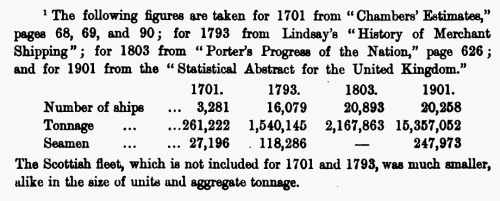
In the nineteenth century, the tonnage increased
eightfold, but in view of the adoption of steam the actual carrying
capacity was augmented nearly thirtyfold; the average size of ship
increased to 760 tons. Practically, every ship in the eighteenth century
carried guns, the average being two per vessel. It was not until 1853 that
there was omitted from the mail contracts the clause which provided that
each mail vessel must be built to carry guns of the largest calibre in
use.
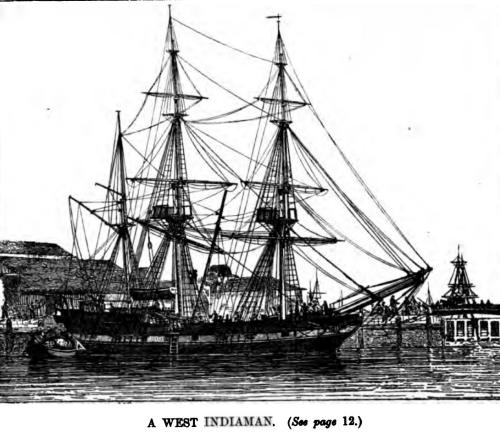
The nineteenth century brought every incentive to
the development of shipbuilding. Nelson taught the lesson, never to be
forgotten, that sea-power is essential to the commercial expansion—even to
the existence—of our island kingdom, with its corollary, that the merchant
fleet is as necessary to this mastery of the sea as fighting squadrons.
The sea became our home; there arose a renewed love of exploration, and an
ambition for colonisation. Succeas brought the chastening influence of
responsibility, with a higher appreciation of the advantage of a
conciliatory policy towards foreign nations. Contemporaneously with the
growth of this conception of empire there arose a war of retaliation in
shipping with the newly - formed United States of America, which continued
for half a century. Although not without its regrettable incidents, it
stimulated a rivalry in the shipping and shipbuilding industries which was
ultimately as beneficial as it had been pronounced. The monopoly of the
East India Company in the Eastern shipping trade terminated, so far as
India was concerned, in 1814, and as regards China in 1834. This removed
an influence which had hitherto retarded enterprise in naval
construction—especially on the Clyde—due to the Company's preference for
building their ships in India, and in the south of England ports. Private
owners, too, entered more vigorously into competition with American
clippers which had first commenced trade with China in 1788.
With the widening of the maritime interests and the
intensification of competition there was awakened a general desire to
increase the strength of ships. In this respect, as in others, there had
been little advance either in the Navy or in the mercantile marine. It was
exceptional for a ship of the eighteenth century to continue in service
for more than twelve or fifteen years. This was due partly to defective
constructional details, and partly to the ineffective methods of
preserving timber.
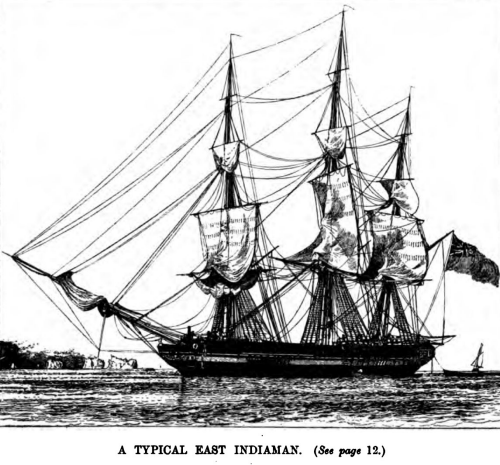
Ships were then built up' of a series of transverse
ribs, connected together by the outside planking and by the ceiling. There
was no filling between the ribs. The ship's structure thus suffered
severely from hogging and sagging stresses. The French tried to improve
this by introducing oblique iron riders across the ceiling, or by laying
the ceiling and the outside planking diagonally, while in other instances
the whole was strengthened with vertical or diagonal riders; but none of
these systems gave complete satisfaction. The Sopping system was
introduced about 1810, and was early adopted by the Scotts. The bottom of
the ship was formed into a solid mass of timber. The beams were connected
with the side of the ship by thick longitudinal timbers below the knees,
and by other stiffening members. A trussed frame was laid on the inside of
the transverse frame in the hold of the ship, and the decks were laid
diagonally. These members bound the ship in all directions, so as to
resist the stresses due to the ship working in a seaway.
The method of preserving the timber adopted at the
beginning of the eighteenth century was to char the inner surface of the
log, while the outer surface was kept wet; but this was superseded early
in the century by the stoving system, which consisted in placing timber in
wet sand, and subjecting it to the action of heat, for such time as was
necessary to extract the residue of the sap and bring the timber to a
condition of suppleness. This process continued until 1736, after which
the timber itself was steamed. Copper sheathing was first employed on
warships in 1761; prior to this lead had been used, but only occasionally.
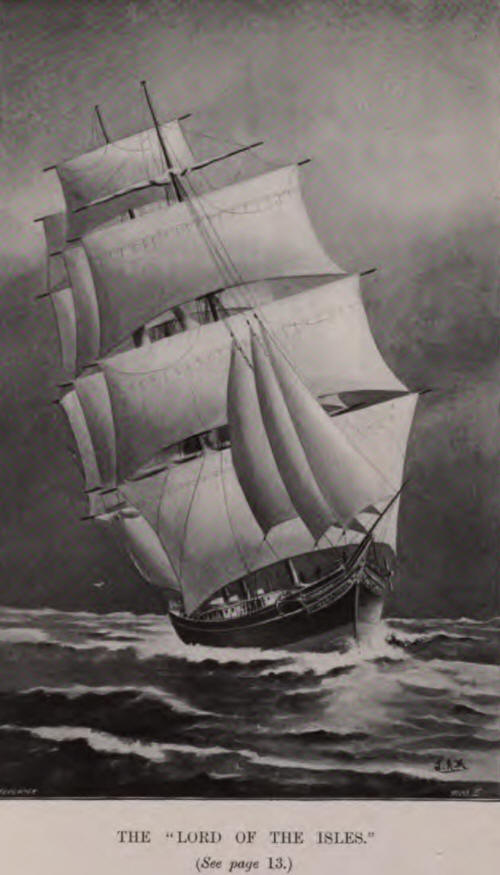
American shipbuilders held an important position,
even in the British trade, for some time after the Declaration of
Independence; but there was then developed a pronounced spirit of
emulation amongst the British firms, which had a marked effect on
competition in western seas. At the beginning of the nineteenth century
much of the oversea work done by the Scotts was for the West Indian trade.
The vessels were not often of more than 600 tons, but the firm continued
steadily to develop their business.
Between 1773 and 1829, the period of expansion under
the second John Scott, to which we have already referred, the output was
16,800 tons.' This output included a succession of fine ships for the West
India trade, to the order of some of the old Glasgow companies, amongst
the number being Stirling, Gordon and Company; J. Campbell and Company;
James Young and Company; and Muir and Fairlie. We may mention as typical
ships, the Grenada, of 650 tons burden, and the John Campbell, of 446
tons, built in 1806, the first ships launched on the Clyde with all
rigging in position.
Thus early, too, the Scotts had entered upon the
construction of that long series of yachts, sailing and steam, which has
brought them considerable repute, and even more pleasure, since they were
in successive generations. noted yachtsmen. In 1803 they launched the
45½.-ton cutter for Colonel Campbell, of the Yorkshire Militia, which was
pronounced one of the completest of the kind ever built in Scotland up to
that time. It may be incidentally mentioned, that the Scotts also showed
thus early their practical sympathy with the auxiliary forces of the Crown
by being at the head of the volunteer Sea Fencibles formed on the Clyde in
the stormy years of the Napoleonic wars.
As soon as the monopoly of the East India Company
was removed in 1814, private shipowners entered the lists, and the Scotts
were early occupied in the construction of Indo-China clippers. In 1818
they built the Christian, and in 1820 the Belifield, the latter, of 478
tons register, for the London and Calcutta trade. She was one of the first
of a long series. The Kirkman Finlay, of 430 tons, built in 1834, suggests
the name of a firm long and honourably associated with the development of
trade in our great Eastern dependency. The effect of competition was a
reduction in the average rate of freight per ton from India to Britain
from £32 10s. about 1773 to £10 in 1830.
The East India Company about the year 1813 paid S40
per ton for their ships, as against about £25 per ton by other traders;
the latter sum was about the same as that paid in America. The East
Indiaman had a crew in the ratio of one to 10 or 12 tons, while one to 25
tons sufficed for the West Indiaman. The speed of the western ship was
greater, largely by reason of the difference in proportions and lines. The
clipper built on the Clyde and in America had a length equal to five or
six times the beam, against four times the beam in the case of the East
India Company's ships. In the design of these clippers the Scotts took an
important part. Charles Cuningham Scott was then at the head of the
concern. An ingenious method of making model experiments in the graving
dock at the works was evolved in the 'forties, whereby the firm were able
to arrive at the most satisfactory form of hull to give the minimum of
resistance, and at the same time a large capacity for cargo per registered
ton. In this latter respect they were more successful than the designers
of the East Indiamen, notwithstanding the bluff form of the latter.
As rapidity in answering the helm was a most
important element in tacking, and therefore in speed, the firm about this
time prepared full-rigged models, about 5 ft. long, for experimental
trials as to the ship's form and rudder, on Loch Thom, on the hill above
Greenock, in an exposed place where the conditions of wind were analagous
to those at sea. The results proved satisfactory. In fact, in these years,
when the Minerva, Acbar, and other noted clippers were built, the care
used in design and construction was almost as great as that now devoted in
the case of racing yachts.
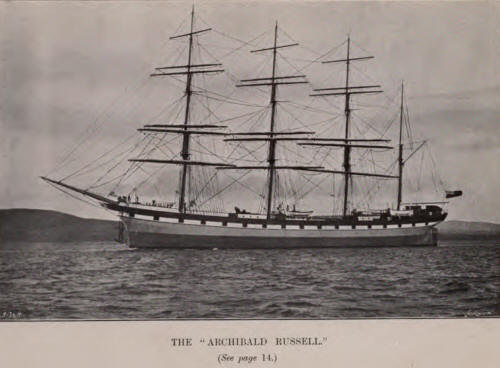
The Scotts, in the first half of the nineteenth
century, continued to produce a long series of successful sailing ships,
while at the same time taking a creditable part in the evolution of the
steamship. Steam, however, was not possible in long-distance voyages until
pressures had been increased, and coal consumption reduced to moderate
limits; and thus it came that, although the steam engine was used in the
early years of the nineteenth century in river, and later in coasting,
craft, the sailing ship continued supreme almost until the middle of the
century. We do not propose, however, to refer to all of the later sailing
ships built by the Scotts, but it may be interesting to give some details
of the construction.
American rock elm was largely used. The frames were
in three sections with scarfed joints, bolted together, the scantlings
being reduced towards the top, so as to lower the centre of gravity.
Inside the frames there were at various heights longitudinal timbers, to
add to the fore-and- aft strength. The top sides were of greenheart, the
beams of oak or greenheart, with wrought-iron knees; the height between
the beams was made to admit of two hogsheads of sugar being placed in the
hold. There were side-stringers, sometimes 10 in. thick, between the floor
and the beams, which were half-checked into the stringers. On the top of
the beams there were deck-stringers. There was a most effective transverse
and longitudinal binding, brass bolts being extended right through the
knee, stringer, frame, and skin of the ship. The decks were of yellow or
Dantzig white pine. An 800 or 1000-ton West Indiaman occupied about nine
months in construction. The last wooden ship built in Greenock was the
Canadian, completed by the Scotts in 1859.
The highest conception of the iron sailing ship, as
built by the firm, was probably embodied in the Lord of the 181e8,
completed in 1856. She had a length between perpendiculars of 185 ft., a
breadth of 29 ft.—the proportion being thus 6.4 of length to 1 of
beam—with a depth of hold of 18 ft. Her registered tonnage was 691 tons,
and her builders' measurement 770 tons. Although a fine-ended ship she
carried a large cargo on board, and made her first trip to Sydney in
seventy days, which had not then been surpassed.' She made the passage
from Shanghai to London in eighty-seven days, with 1030 tons of tea on
board. In one trip she averaged 320 nautical miles for five consecutive
days. When engaged in the celebrated race for the delivery of the season's
teas from Foo-chow-foo to London, in 1856, the Lord of the Isles beat two
of the fastest American clippers, of almost twice her tonnage. She
"delivered her cargo without one spot of damage, and thus British ships
regained their asoendency in the trade which their American rivals had far
too long monopolised."2 From that time the British sailing ships gradually
gained a complete superiority over the American vessels, and carried all
before them, until they in turn were supplanted by the British steamship.
From time to time an occasional sailing ship was constructed of steel; the
latest, the Archibald Russell, is illustrated. Built for Messrs. John
Hardie and Company, this vessel has a length, between perpendiculars, of
278 ft., a beam of 43 ft., and a depth, moulded, of 26 ft., and carries
3930 tons of deadweight cargo on a draught of 21 ft. 7½ in. But less than
1 per cent. of ships now constructed depend upon the unbought but
uncertain winds, and then only for special trades. On regular routes the
steamer is now almost paramount, and it was, therefore, appropriate in the
highest degree that the first vessels to steam regularly to China, via the
Cape, should, like the Lord of the Isles, be built by the Scotts; but that
belongs to another story.
|

